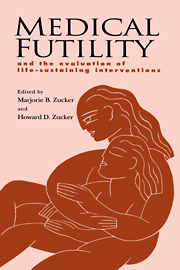Book contents
- Frontmatter
- Contents
- Preface
- Foreword
- Contributors
- 1 Medical futility: a useful concept?
- 2 Death with dignity?
- 3 Physicians and medical futility: experience in the critical care setting
- 4 Physicians and medical futility: experience in the setting of general medical care
- 5 Futility issues in pediatrics
- 6 Medical futility: a nursing home perspective
- 7 Alternative medicine and medical futility
- 8 How culture and religion affect attitudes toward medical futility
- 9 When religious beliefs and medical judgments conflict: civic polity and the social good
- 10 Conflict resolution: experience of consultation-liaison psychiatrists
- 11 Ethics committees and end-of-life decision making
- 12 The economics of futile interventions
- 13 Medical futility: a legal perspective
- 14 Professional and public community projects for developing medical futility guidelines
- 15 Community futility policies: the illusion of consensus?
- 16 Not quite the last word: scenarios and solutions
- Index of cited authors, cases, and statutes
- Subject index
2 - Death with dignity?
Published online by Cambridge University Press: 11 September 2009
- Frontmatter
- Contents
- Preface
- Foreword
- Contributors
- 1 Medical futility: a useful concept?
- 2 Death with dignity?
- 3 Physicians and medical futility: experience in the critical care setting
- 4 Physicians and medical futility: experience in the setting of general medical care
- 5 Futility issues in pediatrics
- 6 Medical futility: a nursing home perspective
- 7 Alternative medicine and medical futility
- 8 How culture and religion affect attitudes toward medical futility
- 9 When religious beliefs and medical judgments conflict: civic polity and the social good
- 10 Conflict resolution: experience of consultation-liaison psychiatrists
- 11 Ethics committees and end-of-life decision making
- 12 The economics of futile interventions
- 13 Medical futility: a legal perspective
- 14 Professional and public community projects for developing medical futility guidelines
- 15 Community futility policies: the illusion of consensus?
- 16 Not quite the last word: scenarios and solutions
- Index of cited authors, cases, and statutes
- Subject index
Summary
I was told by two physicians in 1985 that there was no such thing as death with dignity. They were the then president of the Massachusetts Citizens for Life, Dr. Joseph Stanton, and the physician-in-chief of the New England Sinai Hospital, Dr. Richard Field. I vehemently disagreed with them. The following story explains my position.
Paul Brophy was the youngest of nine children in an Irish Catholic family. His mother, with her famous Irish wit, described her family as three and a half dozen children. You may ask “How can that be?” Well, there were three girls and a half dozen boys.
I knew Paul since we were children. We lived exactly a mile apart. We attended the same church and Sunday School. We became good friends in high school, began dating, eventually married, and had a large, Irish Catholic family of our own. Paul was a healthy, hearty person who loved life, family, and work. In his spare time, he especially enjoyed hunting, fishing, camping, and gardening, in that order. He had been a firefighter and emergency medical technician (EMT) with the fire department in Easton, Massachusetts. He was an active member of the Easton Permanent Firefighters Association, president of the Association for two terms, and an integral part of its negotiating team. When it came to negotiating the fire department contract with the town, he possessed a fierce and competitive spirit.
We had been married nearly 25 years and Paul was 45 years old when tragedy struck.
- Type
- Chapter
- Information
- Medical FutilityAnd the Evaluation of Life-Sustaining Interventions, pp. 15 - 23Publisher: Cambridge University PressPrint publication year: 1997
- 2
- Cited by

